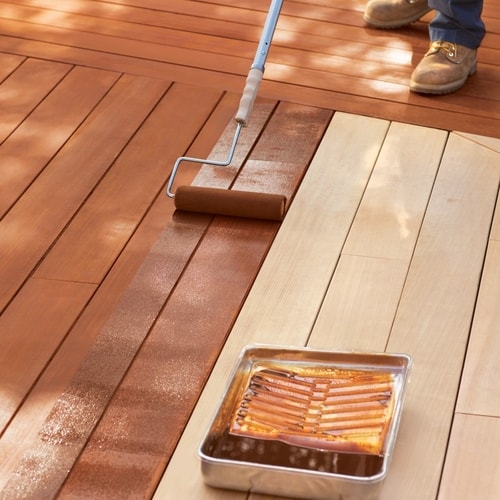Chicago Deck Staining Professionals: Highlighting the most effective in Your Deck
Chicago Deck Staining Professionals: Highlighting the most effective in Your Deck
Blog Article
A Comprehensive Guide to Different Sorts Of Deck Discoloration Techniques for Ultimate Defense and Aesthetics
In the world of deck upkeep, the art of staining stands as a crucial step in the direction of both protecting the integrity of your outdoor space and enhancing its visual appeal. As we navigate via the elaborate world of deck discoloration strategies, one begins to appreciate the nuanced methods that can make all the difference between a sub-par finish and a perfect one.
Understanding Different Kinds of Stains
Different sorts of stains are frequently utilized in the process of deck staining to achieve different visual and protective effects. Transparent discolorations are ideal for showcasing the natural grain of the wood while supplying very little defense versus UV rays and moisture. On the various other hand, semi-transparent discolorations offer an equilibrium in between color enhancement and security, permitting some wood grain to reveal with. For a more opaque finish that supplies maximum defense versus the components, solid discolorations are the recommended selection. These discolorations are available in a large range of colors and properly hide the wood grain.
In addition, there are likewise specialized stains such as toners and sealants. Toners add a tip of color to the timber while supplying marginal defense, making them ideal for more recent decks with much less wear. Sealers, on the other hand, offer protection versus moisture and UV rays without including shade, making them a preferred option for decks that currently flaunt a desirable hue. Recognizing the features and benefits of each sort of tarnish is vital for attaining the desired look and sturdiness for your deck.
Selecting the Right Spot Color
When considering the appearances of your deck discoloration project, the selection of discolor shade plays a critical duty in boosting the safety qualities of the selected tarnish type (Water-Based Stains). The color you choose can substantially affect the general look of your deck, along with its capability to stand up to the aspects gradually
When selecting a stain shade, it's necessary to take into consideration the existing color pattern of your home's outside. Harmonizing the deck tarnish with the general aesthetic of your home can produce a cohesive and visually enticing outside area. In addition, the shade of your deck stain can affect the temperature of the deck surface area; darker shades often tend to absorb even more warm, while lighter shades mirror sunlight and remain cooler.
Additionally, the kind of timber you are tarnishing will certainly likewise influence just how the tarnish shade shows up. Various wood types can interact with the discolor in various means, possibly modifying the final color. It's suggested to check the stain on a small, inconspicuous area of the deck to ensure the color ends up as wanted prior to proceeding with the entire task.
Preparing Your Deck for Staining
To guarantee a durable and effective deck staining project, complete preparation of the deck surface area is necessary. Begin by cleaning up the deck completely to remove dust, gunk, mildew, and any type of old tarnish or complete. Make use of a deck cleaner or a combination of water and detergent in addition to a stiff brush or stress washing machine to scrub the surface tidy. After cleaning, permit the deck to completely dry totally before carrying on to the following action.
Examine the deck for any type of damaged or rotten boards that require visit the website to be changed. Hammer down any kind of protruding nails and sand any kind of rough locations to make sure find out a smooth surface for discoloration. Inspect for any kind of loose railings or actions that might require tightening up or fixing.
As soon as the deck is tidy, completely dry, and in great repair service, think about using a timber brightener to bring back the deck's natural color and open the timber pores for much better discolor penetration. Safeguard any neighboring plants, furnishings, or surfaces with plastic bed linen before proceeding with the discoloration procedure. Proper prep work is vital to accomplishing a professional-looking surface and making the most of the longevity of your deck stain.
Using Stain With Various Techniques
For a remarkable and expert coating, the method of using discolor plays an essential role in enhancing the appearance and toughness of your deck. There are numerous techniques you can use to make certain an effective application of tarnish.
Cleaning is a standard method that enables precision and control over the amount of tarnish used. It is perfect for elaborate areas and getting to between deck boards (Right Deck Stain). Rolling is a quicker choice, covering bigger area effectively. Nonetheless, back-brushing after rolling is recommended to level the tarnish and function it right into the timber for much better penetration.
Splashing is another prominent strategy, providing rate and simplicity of application, especially for large deck areas. It is very important to make use of a high-quality sprayer and bear in mind overspray. Pad applicators offer a smooth and even complete and appropriate for both vertical and horizontal surfaces. Whichever strategy you select, ensuring correct preparation and complying with maker standards will help accomplish a lasting and beautiful tarnish surface on your deck.

Keeping and Re-staining Your Deck
Correct upkeep and timely re-staining are essential for maintaining the elegance and durability of your deck. Normal maintenance tasks include brushing up off debris, cleansing with a deck cleaner, and examining for any type of indications of wear or damages. Dealing with issues without delay can avoid much more substantial troubles in the future. When it comes to re-staining your deck, the frequency relies on different aspects such as the type of tarnish used, the environment in your location, and just how much More Help damage your deck experiences. Generally, it is recommended to re-stain your deck every 2-4 years to maintain its protection and looks.
Prior to re-staining, make certain the deck is clean, completely dry, and totally free of any kind of previous discolor residue. Sanding might be required to smooth out rough areas or get rid of old tarnish that is flaking. Select a high-quality discolor that matches your deck's product and offers the preferred degree of security. Apply the discolor evenly using the suitable method reviewed earlier in this overview to ensure a attractive and durable coating - Stain Deck. By staying proactive with upkeep and re-staining, you can appreciate a aesthetically appealing and well-protected deck for years ahead.
Final Thought
Finally, understanding the various sorts of deck spots, selecting the best color, appropriately preparing the deck, using discolor with different techniques, and re-staining the deck and keeping are vital steps for supreme protection and aesthetic appeals. By following these steps, you can ensure that your deck continues to be in top problem for many years to find.
Additionally, the shade of your deck discolor can affect the temperature level of the deck surface area; darker colors have a tendency to absorb more warm, while lighter shades mirror sunshine and remain cooler.
It's a good idea to test the discolor on a little, inconspicuous area of the deck to make sure the shade transforms out as wanted before continuing with the whole project.

Report this page